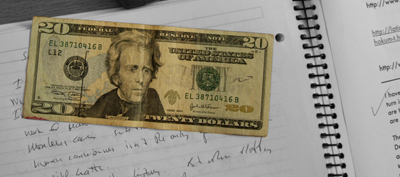

I have been staring at a $20 bill on my desk for an hour now but it has yet to turn into $40. If I think about this blog really hard, will it write itself? There are those who believe beliefs can manifest into things, that action and thought are entangled.
There's a kind of chocolate on the market called Intentional Chocolate. Dr. Dean Radin, a senior scientist at the Institute of Noetic Sciences, co-authored a study on it, a randomized, placebo-controlled double-blind study, to see whether chocolate exposed to the positive intentions of people meditating would make a difference in the mood of people who ate the chocolate. Turns out, according to the paper, that people who ate the "positive thought" chocolate reported feeling better than those who ate regular chocolate. Huh. Would that work with pizza?
Dr. Radin admits to being surprised at the outcome of the test, but he says he's interested in asking questions about how the world works, regardless of prejudices.
Well, scientists do tend to freak out when you suggest that the consciousness of somebody can change the outcome of an experiment. Richard P. Sloan, a professor of behavioral medicine in the Department of Psychiatry at Columbia University, was quoted in the Los Angeles Times about the chocolate experiment: "There's nothing in the way that we understand the universe that would explain how a group of people could influence the well-being of others by blessing their chocolate," he was quoted in the article. "Besides, if chocolate could be blessed, it could also be cursed."
Cursed chocolate bunnies aside, Dr. Sloan is an important crusader against quack science and I admire his stand. But there are other beliefs about belief.
One of the premises of quantum physics is that the observer, by the act of watching, affects observed reality. Trying to get my brain around that makes me want to lie down in a darkened room and eat chocolate. But according to a study published in Nature, scientists have demonstrated how a beam of electrons is affected by the act of being observed.
Dr. William Tiller, a Professor Emeritus of materials science at Stanford, believes that human consciousness can change what we call physical reality. His view is that physics has been examining the interaction of mass and energy and he now wants to bring consciousness to the party. He thinks mass can be converted into energy which in turn can be converted into consciousness. That supports the formula t/C*10=a2. That is, thinking (t) about consciousness ( C ) for ten minutes equals taking two Advil (a2) and lying down in a darkened room.
We all know the saying "I'll believe it when I see it." It's at the heart of "show me" scientific thinking. Dr. Radin argues we have this backwards. It should be, he says, "I'll see it when I believe it."
Lynne McTaggart is one researcher who is taking a close look at this, inviting people worldwide to participate in her intention experiments. Using her website, people hook up to sync up and send an intention to a war zone, a hot spot, or a person. She reports that thousands of volunteers from 30 countries around the world have participated in intention experiments thus far. The results? Researchers working with her report that focusing "grow" intention on plant seedlings may have given them more energy and caused more of them to sprout than normal. A recent experiment focused an intention of peace toward war-torn Sri Lanka and coincidentally or not could have reduced violence there. McTaggart is planning more intention experiments. Like Dean Radin, she seems interested in asking questions about how the world works, regardless of prejudices.